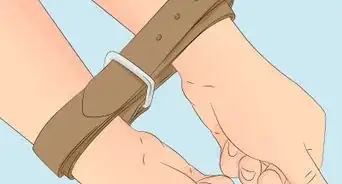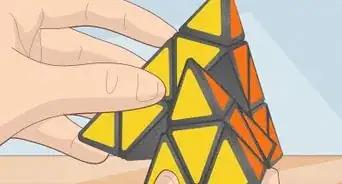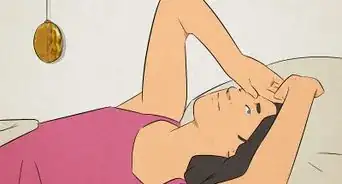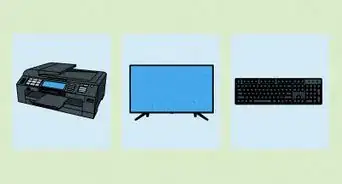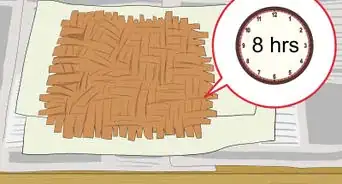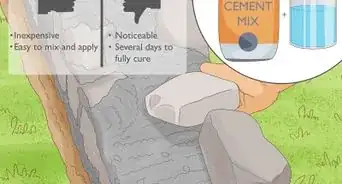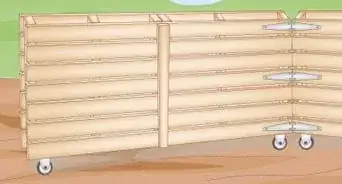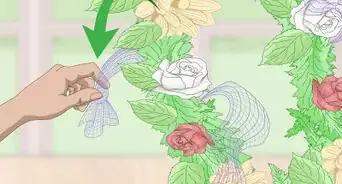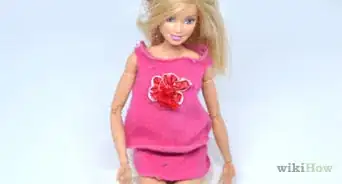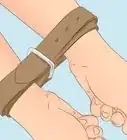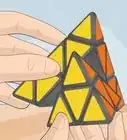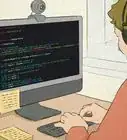This article was co-authored by wikiHow staff writer, Jessica Gibson. Jessica Gibson is a Writer and Editor who's been with wikiHow since 2014. After completing a year of art studies at the Emily Carr University in Vancouver, she graduated from Columbia College with a BA in History. Jessica also completed an MA in History from The University of Oregon in 2013.
The wikiHow Video Team also followed the article's instructions and verified that they work.
This article has been viewed 64,610 times.
Learn more...
Tiny needle holes are inevitable when you unpick a hem, remove embroidery, or take off a pocket. Fortunately, a few simple tricks can restore the fabric and make it look perfectly smooth. You don't even need fancy tools! Grab a spoon and heat up an iron. You'll use a combination of moisture, heat, and scraping the fabric to remove those irritating needle marks.
Steps
Moving Fibers Back in Place
-
1Spray the fabric with water to relax the fibers. Fill a clean spray bottle with water and squirt enough water on the holes to moisten the fabric fibers. Since your goal is to fill the tiny holes with the fabric's own fibers, loosening the fibers makes them easier to adjust. [1]
- If you're fixing delicate fabrics like silk or satin, don't spray them with water since this can damage the material.
-
2Scrape your nail or a spoon from side to side over a needle mark. To help close up the tiny holes in horizontal threads, scrape the tip of your fingernail or the edge of a spoon from side to side. Do this for each needle mark.[2]
- If your fabric is thick or stiff, press firmly as you scrape over the holes.
- Fabric is made by weaving threads vertically and horizontally. The horizontal threads are the weft threads of the fabric.
Advertisement -
3Scratch your nail or spoon up and down over the hole. Once you've brought the weft fibers together, scrape up and down to shift the vertical fibers. Repeat this for each needle mark. As you work, the needle marks should close up.[3]
- The vertical threads of fabric are the warp threads.
-
4Repeat the process if you still see needle marks. Depending on your fabric, the needle marks might be completely invisible. If you can still spot them, spray the fabric with water again and scrape your fingernail or spoon over the holes. Then, look for needle marks.[4]
- The number of times you repeat the process depends on the size of the needle marks, the fabric material, and the material's thread count.
-
5Flip the fabric over and repeat the process. Once you've worked on 1 side of the fabric, turn it over. Repeat all of the steps to completely close the needle marks. Keep in mind that you probably won't need to spend as much time scraping this side of the fabric.[5]
Ironing the Needle Marks
-
1Spritz the fabric with water and leave it for a few minutes. Pour water into a clean spray bottle and squirt water onto the needle marks. Let the fabric absorb the moisture and sit for a few minutes so the fibers relax. This makes the needle marks close easily.[6]
- Avoid spraying delicate fabrics like silk or satin with water since moisture could damage them.
- You can also try tossing the fabric in your washing machine and running a cycle. In some cases, this is all it takes to hide the needle marks.
-
2Heat an iron according to your fabric type. Set up an ironing board and set your iron on it. Then, read the care label for the fabric and heat your iron to the appropriate setting. For example, if you're working with cotton, heat the iron to medium-high heat.[7]
- If you're unsure which temperature to use, heat the iron to warm.
-
3Press the iron onto the needle-marked fabric. Spread the fabric on an ironing board and press the iron directly onto the needle marks. Hold it in place for about 10 seconds before you lift the iron off. If there are several needle marks, run your iron over the area to help close the holes.[8]
- Use steam on the fabric if it can handle the heat and moisture. The pressure and steam from the iron help the fibers shift back into place.
Removing Stitches from Fabric
-
1Use a seam ripper to cut through hand stitches or machine stitches. A seam ripper is a great tool for pulling out a row or just a few stitches. The seam ripper looks like a small, sharp hook that you slide under the stitch. Then, pull up sharply to slice the stitch. Repeat this anywhere on the fabric where you want to remove stitches.[9]
- Turn the fabric over and work on the backside to minimize the size of the needle marks.
-
2Run a stitch eraser over the fabric to remove embroidery stitches. If you'd like to take out sturdy embroidery stitches that were made by a machine, buy a stitch eraser, which looks like small hair clippers or trimmers. Turn the fabric to the backside and slowly hold the stitch eraser over the embroider to shave the threads. Then, brush away the loose threads.[10]
- You can buy a stitch eraser at your local craft store or online.
- Hold the eraser blade so it's perpendicular to the embroidery threads.
-
3Take a pair of tweezers and pluck the loose stitches out of the fabric. Once you've sliced through the stitches or used the stitch eraser, use tweezers to pull the loose strands of thread from the fabric.[11]
- If it's easier, use your fingertips to pull the stitches out.
Things You'll Need
Moving Fibers Back in Place
- Spray bottle
- Spoon
Ironing the Needle Marks
- Iron
- Ironing board
- Spray bottle
Removing Stitches from Fabric
- Seam ripper
- Embroidery eraser
- Tweezers
References
- ↑ https://youtu.be/Qi-64Ez42Q8?t=28
- ↑ https://makery.co.uk/2015/07/how-to-remove-stitch-marks-from-fabric/
- ↑ https://youtu.be/Qi-64Ez42Q8?t=37
- ↑ https://makery.co.uk/2015/07/how-to-remove-stitch-marks-from-fabric/
- ↑ https://makery.co.uk/2015/07/how-to-remove-stitch-marks-from-fabric/
- ↑ https://youtu.be/Qi-64Ez42Q8?t=28
- ↑ https://youtu.be/Qi-64Ez42Q8?t=55
- ↑ https://youtu.be/Qi-64Ez42Q8?t=51
- ↑ https://sewguide.com/remove-embroidery-from-clothes/

